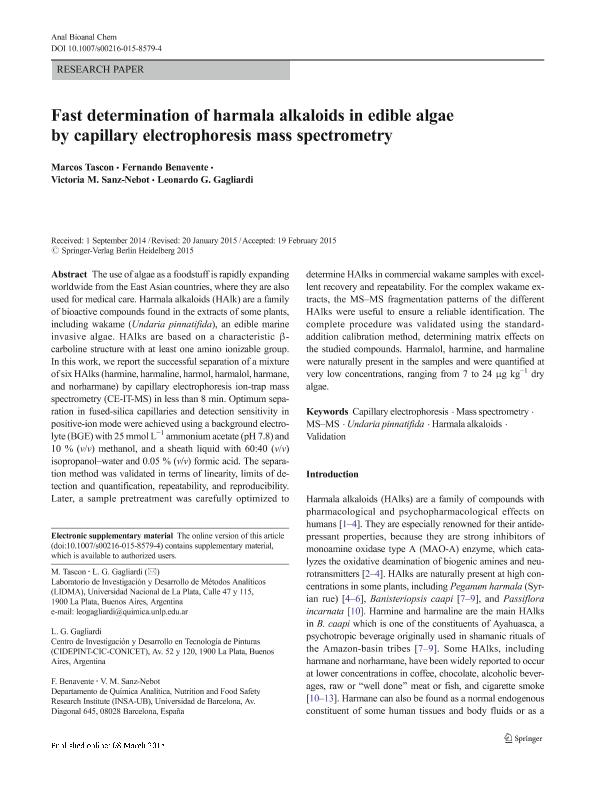Mostrar el registro sencillo del ítem
dc.contributor.author
Tascon, Marcos

dc.contributor.author
Benavente, Fernando
dc.contributor.author
Sanz Nebot, Victoria M.
dc.contributor.author
Gagliardi, Leonardo Gabriel

dc.date.available
2017-03-09T21:20:39Z
dc.date.issued
2015-05
dc.identifier.citation
Tascon, Marcos; Benavente, Fernando; Sanz Nebot, Victoria M.; Gagliardi, Leonardo Gabriel; Fast determination of harmala alkaloids in edible algae by capillary electrophoresis mass spectrometry; Springer Heidelberg; Analytical And Bioanalytical Chemistry; 407; 13; 5-2015; 3637-3645
dc.identifier.issn
1618-2642
dc.identifier.uri
http://hdl.handle.net/11336/13717
dc.description.abstract
The use of algae as a foodstuff is rapidly expanding worldwide from the East Asian countries, where they are also used for medical care. Harmala alkaloids (HAlk) are a family of bioactive compounds found in the extracts of some plants, including wakame (Undaria pinnatifida), an edible marine invasive algae. HAlks are based on a characteristic β-carboline structure with at least one amino ionizable group. In this work, we report the successful separation of a mixture of six HAlks (harmine, harmaline, harmol, harmalol, harmane, and norharmane) by capillary electrophoresis ion-trap mass spectrometry (CE-IT-MS) in less than 8 min. Optimum separation in fused-silica capillaries and detection sensitivity in positive-ion mode were achieved using a background electrolyte (BGE) with 25 mmol L−1 ammonium acetate (pH 7.8) and 10 % (v/v) methanol, and a sheath liquid with 60:40 (v/v) isopropanol–water and 0.05 % (v/v) formic acid. The separation method was validated in terms of linearity, limits of detection and quantification, repeatability, and reproducibility. Later, a sample pretreatment was carefully optimized to determine HAlks in commercial wakame samples with excellent recovery and repeatability. For the complex wakame extracts, the MS–MS fragmentation patterns of the different HAlks were useful to ensure a reliable identification. The complete procedure was validated using the standard-addition calibration method, determining matrix effects on the studied compounds. Harmalol, harmine, and harmaline were naturally present in the samples and were quantified at very low concentrations, ranging from 7 to 24 μg kg−1 dry algae.
dc.format
application/pdf
dc.language.iso
eng
dc.publisher
Springer Heidelberg

dc.rights
info:eu-repo/semantics/openAccess
dc.rights.uri
https://creativecommons.org/licenses/by-nc-sa/2.5/ar/
dc.subject
Capillary Electrophoresis
dc.subject
Ms-Ms
dc.subject
Undaria Pinnatifida
dc.subject
Harmala Alkaloids
dc.subject.classification
Química Analítica

dc.subject.classification
Ciencias Químicas

dc.subject.classification
CIENCIAS NATURALES Y EXACTAS

dc.title
Fast determination of harmala alkaloids in edible algae by capillary electrophoresis mass spectrometry
dc.type
info:eu-repo/semantics/article
dc.type
info:ar-repo/semantics/artículo
dc.type
info:eu-repo/semantics/publishedVersion
dc.date.updated
2017-03-08T15:40:10Z
dc.identifier.eissn
1618-2650
dc.journal.volume
407
dc.journal.number
13
dc.journal.pagination
3637-3645
dc.journal.pais
Alemania

dc.journal.ciudad
Heidelberg
dc.description.fil
Fil: Tascon, Marcos. Universidad Nacional de La Plata. Facultad de Ciencias Exactas. Laboratorio de Investigación y Desarrollo de Métodos Analíticos; Argentina. Consejo Nacional de Investigaciones Científicas y Técnicas; Argentina
dc.description.fil
Fil: Benavente, Fernando. Universidad de Barcelona; España
dc.description.fil
Fil: Sanz Nebot, Victoria M.. Universidad de Barcelona; España
dc.description.fil
Fil: Gagliardi, Leonardo Gabriel. Universidad Nacional de La Plata. Facultad de Ciencias Exactas. Laboratorio de Investigación y Desarrollo de Métodos Analíticos; Argentina. Consejo Nacional de Investigaciones Científicas y Técnicas. Centro Científico Tecnológico La Plata. Centro de Investigación y Desarrollo en Tecnología de Pinturas (i); Argentina. Provincia de Buenos Aires. Gobernación. Comisión de Investigaciones Científicas; Argentina
dc.journal.title
Analytical And Bioanalytical Chemistry

dc.relation.alternativeid
info:eu-repo/semantics/altIdentifier/doi/http://dx.doi.org/10.1007/s00216-015-8579-4
dc.relation.alternativeid
info:eu-repo/semantics/altIdentifier/url/https://link.springer.com/article/10.1007%2Fs00216-015-8579-4
Archivos asociados
